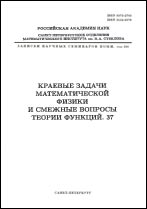|
|
Zapiski Nauchnykh Seminarov LOMI, 1979, Volume 88, Pages 47–55
(Mi znsl3101)
|
 |
|
 |
This article is cited in 2 scientific papers (total in 2 papers)
Time bounds of multidimensional Turing machines
D. Yu. Grigor'ev
Abstract:
Two methods of simulating multidimensional multi-head Turing machines are suggested. The first method allows one to obtain the following two results. If a predicate $P$ can be recognized by a $m$-dimensional
nondeterministic Turing machine within a time $t$ and space $L$ then it can be recognized
(1) by а $K$-dimensional ($k\leq m$) nondeterministic Turing machine within time $tL^{1/k-1/m+\varepsilon}$, so that the computation proceeds in а $k$-dimensional cube with the side $\leq L^{1/k+\varepsilon}$ (for any $\varepsilon>0$);
(2) by $(m+1)$-dimensional nondeterministic Turing machine within time $t\log^2L$ so that the computation proceeds in a $(m+1)$-dimensional cube with the side $\leq L^{1/(m+1)+\varepsilon}$ (for any $\varepsilon>0$).
These results can be interpretated in the following way. The computation on a nondeterministic Turing machine can be “packed” on account of some increasing the time (depending on a dimension) because initial trajectories of the heads could have been scattered.
Earlier [5] the author obtained a time-bound for simulating a deterministic multidimensional Turing machine by a machine of lower dimension. The method of [5] allows one to obtain the same bound for nondeterministic multidimensional Turing machines. The result (1) improves this nondeterministic bound.
The second method of simulation allows us to generalize to multidimensional case the well-known result due to Hopcroft, Paul, Valiant [1]. Namely, if a predicate $P$ can be recognized by a $m$-dimensional Turing machine within time $t\log^{1/m}t$ ($t(n)\geq n$ for every $n$) then $P$ can be recognized by a random access machine (RAM) within time $t$. Moreover one can make this RAM to satisfy the following restriction introduced by Slisenko [3]: the maximum length of a word in any register of RAM is less than $\log t+c$,
where $t$ is the time complexity ($c$ depends only on the considered RAM).
Citation:
D. Yu. Grigor'ev, “Time bounds of multidimensional Turing machines”, Studies in constructive mathematics and mathematical logic. Part VIII, Zap. Nauchn. Sem. LOMI, 88, "Nauka", Leningrad. Otdel., Leningrad, 1979, 47–55; J. Soviet Math., 20:4 (1982), 2290–2295
Linking options:
https://www.mathnet.ru/eng/znsl3101 https://www.mathnet.ru/eng/znsl/v88/p47
|

| Statistics & downloads: |
| Abstract page: | 319 | | Full-text PDF : | 82 |
|




 Contact us:
Contact us: Terms of Use
Terms of Use
 Registration to the website
Registration to the website Logotypes
Logotypes








 Citation in format
Citation in format 
